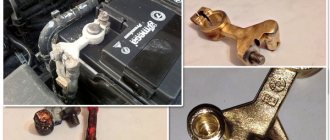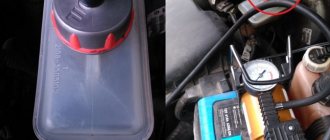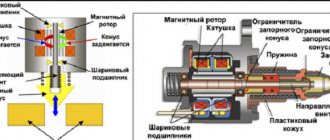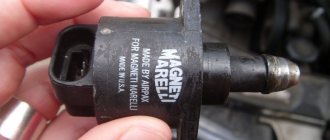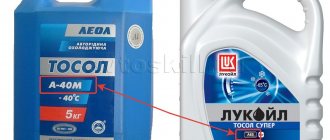- home
- car battery
- …
This problem can manifest itself both in winter (cold) and summer (warm) periods of time, and it practically does not depend in any way on winter starts. What happens when starting or when the engine is already running, one of the battery terminals begins to heat up wildly, if you drop water on it, it will begin to steam. Why does this happen and how to deal with it, let's figure it out...
At the very beginning, I want to say that this malfunction can occur on different cars (the make and model does not matter), and often this can be the reason for the battery failure, and in a very short period of time.
Why does the battery fail?
Just a couple of lines about why the battery may fail:
- Warming up the terminal, and then heating the current output and after the entire battery (including plate packs), provokes the evaporation of distilled water from the electrolyte. As the capacity drops, the plates may crumble and in general, the battery will not last long in this mode.
- If the current lead heats up, it can melt the plastic of the housing that is located next to it. Microcracks appear, through which water from the electrolyte begins to evaporate, and sulfuric acid often gets onto the terminal. Strong “oxides” form on it, which further interfere with the operation of the battery, undercharging and poor starting are possible
- YES, and the most common reason is that the case can melt from high temperatures. This is rare, but it happens; you can no longer use such a power source.
BUT this is not the only danger; a fire is not far away.
The negative terminal gets hot
If the negative terminal gets hot, it is due to poor contact with the body. The latter is used in the form of grounding. Oxidation as a result of the release of electrolyte vapors to the outside can also affect.
To eliminate the causes of heating of the negative terminal, it is recommended to do the following:
- Check whether both ends of the wire are connected well enough.
- Clean the terminal from oxides with sandpaper. If oxides still remain, replace the battery with a new one.
Heating of the ground wire from the battery is not in itself dangerous if it occurs due to a poor connection. In case of oxidation and gradual destruction of the battery, this is dangerous for the lives of other components of the car, to which the problem can spread. The heat may cause the body to melt, which will lead to sulfuric acid leaking into the inside of the car.
Why does the terminal get hot?
Quite large currents flow from the battery to the starter, and then from the generator back to the battery. Just think - starting currents, in winter, can reach up to 600A. If you install a thin wire, it will simply not be able to cope with such a load and will melt before your eyes. This is why the wires are so thick and solid, all because they are designed to carry high loads.
Let's watch a short video.
There are not many reasons and they are all banal:
- The problem is in the terminal itself . There is poor contact between the wire and the fastener, sometimes it comes straight from the factory, a manufacturing defect (for example, the hole in the terminal is 10 mm, and the wire is 8 mm).
- It happens over time that water can get into this place or oxides can form. The bottom line is that wires and fasteners are often made of different metals, the potential difference sooner or later leads to oxidation of the contact point and the current conductivity drops significantly.
- Oxides between the terminal and the current terminal. This also happens, but rarely, if the contact is bad, then the current must pass through a very narrow point of contact. Warming up can come from here.
- The wire . Sometimes the wire itself suffers, say, from an accidental break in the middle that is not visible to the eye. That is, several threads were broken, and the load that he could bear decreased.
- Poor contact with body . Often it is the negative cable and after the terminal that get hot. This is because it is bolted to the car body, and then both the starter and the generator are “powered” from the body. On modern foreign cars, the negative cable is quite short (on some cars it is attached to the engine block). So, the cable will heat up, but you will mistakenly think that it is the terminal (although with such a malfunction, the braiding of the wire itself will most likely begin to recover).
The positive terminal can only heat up from poor contact or, again, from oxides that have formed between the mount and the current terminal.
Why does the positive or negative terminal of the battery get hot?
To understand the reasons why the positive or negative terminal on a battery heats up, you first need to understand what they are and how they work.
Metal terminals are the connecting link between the battery plates and the rest of the vehicle's electrical equipment. International standards provide for the following classification of terminal terminals:
- type A is typical for batteries of the European form factor; these are leads of slightly conical geometry, tapering upward, with different diameters of the positive (95 cm) and negative (1.79 cm) terminals;
- type B is typical for batteries that comply with Japanese standards, the positive terminal has a diameter of 27 cm, the negative - 1.11 cm, which is much smaller than European standard sizes;
- types F, G are characterized by screw or bolt fastening of wires;
- types E, T, such terminals are common in Russia, they can also be found in European-made batteries.
The most common batteries are with terminals A and B - most major manufacturers of car batteries have a line of models containing batteries of these two types.
Often, metal clamps are also called terminals, with the help of which the power cables of the on-board network are connected to the battery terminals. High-quality contact is ensured by tightening the clamps with screws or bolts, which on the other side have a head in the form of a nut.
The electrodes themselves can be attached to the battery in different ways:
- using pressure plates;
- one-piece pressing using a crimping chuck;
- by welding or soldering (version with non-removable terminals).
Minimizing the electrical connection is the main requirement for the quality of the contact connection. Since large currents flow through the conductors of a car battery, an increase in resistance for any reason will lead to heating of the contact group.
To minimize resistance, materials with excellent conductivity (copper, lead, bronze, brass) are used to manufacture terminal terminal parts.
We list other requirements for battery contacts:
- large mass, which reduces the risk of loss of contact when moving a vehicle, which is characterized by shaking and vibration;
- high mechanical strength, maintaining the integrity of the structure after numerous tightenings and loosening of terminal connections;
- high wear resistance;
- resistance to deformation, the ability to maintain its original shape;
- simplicity of design: dismantling the wires and the battery itself should not be difficult.
I give a load - it overheats
This may often be the case. You start the car, everything seems to be fine, but after you turn on the load, say heated seats, mirrors, windshield, etc., the terminal starts to heat up! Why?
And here everything is simple and the reasons that I described above work. The thing is that the generator alone may not be able to cope with such a load (especially when the headlights, radio, and instrument lighting are working); its power is limited . Therefore, part of the energy is taken from the battery, and if your contact is bad, or there are oxides, this place will heat up.
What are the dangers of heating the battery terminals?
If the wires and contact group are in normal condition, the positive terminal of the battery should not heat up. If you notice a significant increase in temperature, a hot electrode does not bode well for the future.
Possible consequences of excessive heating of the terminals:
- Heat from the terminal terminals spreads further along the electrodes to the plates, which leads to boiling of the electrolyte. This is one of the main reasons for shortening battery life. The electrolyte evaporates, the jars dry out, the plates begin to rapidly crumble, and the battery capacity rapidly drops.
- When the contacts are very hot, cracks often form on the plastic cover and battery case, which leads to electrolyte leaks and the consequences described above.
- If the battery terminal heats up so much that the temperature reaches the melting point of the contact group components, they are deformed, further deteriorating the contact area.
In some cases, overheating of the battery terminals occurs only when the power unit is started. This is evidence that the generator is not able to cope with the load from the on-board network, as a result of which part of the power required to power consumers is taken from the battery. If you find that the generator starts with a delay, check the total power consumption of the on-board network - perhaps this is the reason for the overheating.
What to do?
Everything is banal and simple, there are only a few points:
- All oxides must be cleaned. If they repeatedly appear on the surface of the battery, say on one side or the other, you need to look at it for leaks.
- Check the wire for breakdowns and breaks - if there are any, then it is better to replace the wire.
- You need to look at the point of contact between the cable and the terminal. Often this is where the issue lies. If it is negative, you can easily remove it and check it at home. Sometimes it’s easier to cut the cable from the terminal, buy a new one (now they sell improved copper or brass ones for audio equipment, by the way, they have a good fastening, with bolts) and then install it on your car
As a rule, all problems go away immediately. If you don’t do anything, then at a minimum your battery will fail (you won’t start your car), at a maximum and it’s not far from a fire; the wire braid may melt and short out. SO IT IS SURE TO ELIMINATE!
I’ll end with this, I think it was useful, read our AUTOBLOG, subscribe to the YOUTUBE channel.
Similar news
- Gel or acid battery. Which is better? Only facts + B...
- Battery bank. What it is? How many are there? What is the voltage
- Batteries “Europe” and “Asia” - what are they? How to determine and what they...
Add a comment Cancel reply
What to do if the battery terminals get very hot
To prevent premature failure of the contact group or the entire battery as a result of critical heating of the terminals, the following recommendations must be followed:
- When adding equipment, do not use devices whose power, combined with other consumers, exceeds the capabilities of the generator, or are designed for a current that is unacceptable for wiring. In the latter case, you can replace the wires with ones with a sufficient cross-section.
- Make sure that all electrical appliances are in working order. Short circuits are especially destructive.
- When choosing a new battery, pay attention to the geometry and dimensions of the down conductors: they must match the terminals on the on-board power supply cables. If you purchase a battery of a different type, do not be lazy and replace the contact group on the cables.
- Regularly check the condition of the contacts of the electrodes and wire tips; if they become oxidized/contaminated, clean them thoroughly and, if necessary, tighten the bolted connection.
- If damage in the form of chips and cracks is detected on the surface of the contact elements, it is necessary to treat the defects with sandpaper. If this does not bring the desired result, the damaged part must be replaced. Remember that excessive wear on the terminal pins will create air pockets and increase resistance at the contact point.
- Promptly remove oxides that appear on the surface of the terminals as a result of exposure of lead to electrolyte vapors, oxygen and sulfates. To do this, you can use metal brushes, sandpaper, a fine abrasive file, and even a regular knife. After cleaning the terminals from oxides, it is advisable to treat them with a special lubricant that prevents oxygen from accessing the part.
Compliance with these recommendations will increase the life of the metal contacts and the battery as a whole. The situation is more complicated with the contacts on the wire - unlike the battery, they are designed for the entire service life of the car, so their condition must be monitored especially carefully.
The terminal gets hot. Causes and consequences
The conductive elements of the network are characterized by an increased temperature (different from the environment). Ohm's laws and conservation of energy work here 100%. An increase in resistance is the main reason why the negative terminal heats up. The reason for this is weak contact, as well as the presence of:
- Oxide between battery electrodes and wire terminals;
- Air gap;
- Reduced cross-section of current-carrying circuit elements.
As you know, an electrolysis reaction occurs inside the battery, where the role of a conductor is played by a very aggressive environment - sulfuric acid and distillate. A battery terminal covered with a white coating (lead dioxide) is the first sign that the connection is coming into direct contact with the electrolyte or its vapor.
Another reason why the terminals on the wires and the battery itself heat up can be the long operation of the starter. When starting the motor, the starting current often exceeds 150 and even 200 amperes, and this can heat up a fairly thick wire and melt any insulation.
Advice! When starting, do not allow the starter to operate for a long time (more than 30 seconds). If you fail to start the car the first time, try again at intervals of at least half a minute. But remember that each time the terminal heats up more.
As an additional measure to combat the inrush current - in general and the fact that the terminal is heating up - in particular, the negative wire can be replaced with a similar one, but of a larger cross-section.
Eliminating oxidation
The main materials for the terminals of the lead wires from the plus and minus electrodes on car batteries are active metals: lead, brass or copper. That is why their interaction with air oxygen is inevitable. The appearance of a characteristic coating (oxide) on the compounds is the first confirmation of this. This is one of the answers to the question “why does the negative cable from the battery get hot?” We list several ways to eliminate sulfation:
- Cleaning contacts with sandpaper.
- Removing oxide with a file or metal brush.
There are also ways to prevent the oxidation reaction:
- Periodic lubrication. The best options are lithol or solid oil;
- Using a special paste or varnish as protection.
We improve contact and reduce terminal heating
Even such a simple connection as a wire to a battery terminal has its own difficulties. A loose connection between the current-carrying pins and wires leaves an air gap, which provokes an increase in resistance and the possibility of spark formation. How to avoid this:
- The diameter of the terminal ring must be sufficient for the bolted connection to provide a tight contact.
- Even with maximum clamping, there should be a gap between the jaws of the terminal. This will ensure reliability and provide a guarantee for the next tightening.
- To avoid turning the bolt or nut - the clamp on the battery when installing them - it is advisable to use two keys.
- The wire itself, when connected to the terminal, must be in a pressed state. It is better to solder the harness to prevent any movement of the cable cores.
- Even a slight violation of the insulation is not allowed. Remember that sparks under the hood of a car are a harbinger of big trouble.
What kind of cables should be on the terminals?
Every electrical wire and terminal on a vehicle must be standardized and approved for vehicle use. Almost all of them have oil-, gasoline- and heat-resistant insulation that can provide protection at any temperature and chemical exposure.
Important! Even wire insulation that is so indifferent to chemical and mechanical influences is not a reason for negligence in its cleanliness.
It is advisable to connect the battery to the vehicle ground using a braided copper wire.
Important!
This element is very vulnerable when exposed to alkali and acid in places where there is no insulation. In this regard, special care is required when working with process and caustic liquids in the immediate vicinity. Today, a range of high-quality terminals and wires is fairly represented on the spare parts market. When choosing links in the electrical circuit of your car, do not compare external attractiveness and reliability, cost and a trusted manufacturer. Remember - confidence in your vehicle is more important than economy and aesthetics. Poor contact at the terminals and, as a result, their high temperature is a serious cause for concern for car owners. You shouldn’t put off fixing this problem for too long. Moreover, a lot of things can be done here on your own. The topic - why the terminals on the battery heat up - is much wider than the framework in which it fits on this page. If you would like to share your knowledge and experience, leave your comments. This will be very interesting and useful for us and our readers!
Why does the battery terminal get hot?
When starting a car, increased currents flow from the battery to the engine and back from the generator to the battery. In winter, the maximum current reading can reach values of up to 600 A. As a result of the use of thin wires not designed for such amperage, overheating of the wires and the terminals themselves is possible.
Important! The positive and negative wires must be designed for the maximum current readings flowing through them.
Many motorists have encountered a problem when the terminal heats up. The main reasons may be:
- Poor connection between terminals and battery terminals. The reason may be either a manufacturing defect or the passage of time. In this situation, it is necessary to notice and correct it in time.
- The appearance of an oxide film. Such troubles can occur relatively rarely, however, it is necessary to ensure the cleanliness of the battery terminals, as well as the inner surface of the contacts.
- Increased resistance of commutating wires. Over time, refraction of the wires may occur, resulting in their gradual rupture. From the physics course, you can recall that as the cross-sectional area decreases, the resistance of the wire increases. In this case, the faulty conductors should be replaced.
- If the negative terminal of the battery heats up, you need to check the connections to the body. Very often, car owners can be confused, believing that the terminal is heating up, but the heating occurs on the wire.
- The positive terminal on the battery is heating up. The reason here can only be if there is poor contact on the tip or oxides have formed that need to be eliminated. In some cases, overheating may occur as a result of a malfunction of the battery terminals themselves.
